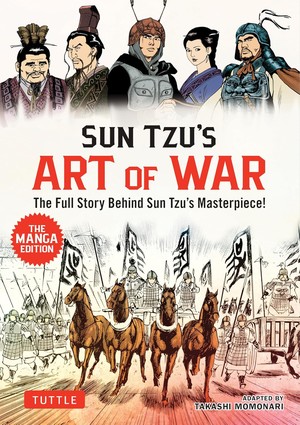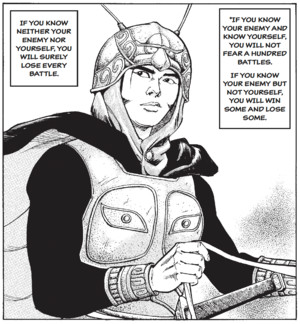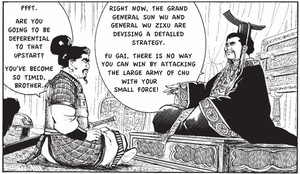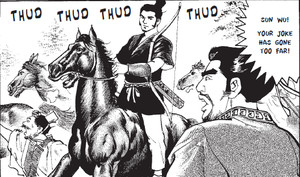The Fall 2025 Manga Guide
Sun Tzu's Art of War: The Manga Edition
What's It About?

The book recounts the conflict between the kingdom of Wu as they plot to attack the far more powerful state of Chu, with both leaders navigating internal plots and power struggles that will forever alter the fate of China. The fascinating accounts in this book include:
The story of Sun Tzu, who became a trusted advisor to the powerful Wu clan and then a master military strategist, capturing the attention of Wu Zixu, the clan's most formidable general The creation of the military strategies in The Art of War, as Sun Tzu develops his revolutionary philosophy of asymmetrical warfare The high-stakes Battle of Boju where Sun Tzu's teachings take center stage, shaping a battle that will become legendary in the chronicles of military history And many other fascinating stories!
Sun Tzu's Art of War: The Manga Edition has art by Takashi Momonari and story by Sun Tzu. English translation is done by Periplus Editions Ltd. Published by Tuttle Books (September 2, 2025). Rated OT.
Is It Worth Reading?
Lauren Orsini
Rating:

I'm getting pretty tired of Tuttle's repeatedly poor-quality translations. Throughout Sun Tzu's Art of War, you'll find spelling errors, grammatical weirdness, stilted phrasing, and even visual blunders like words that spill out of the textbox and onto characters' bodies. Normally, when a book contains typographical errors that are this offensive, I would abandon it mid-read. But for this fascinating historical topic about an enigmatic figure who lived 2,500 years ago, I had to power through—and it even sent me down a Chinese military history research hole afterwards. With an art style that veers more toward realism than cartoonish, this feels like an unusually absorbing history book for those who can muddle through the verbiage.
Before getting to the manga itself, this comic has a prologue that I'd highly suggest not skipping. Hopefully, if you're the kind of person who picks up a history comic, you're not going to be too upset that it comes with its own pre-reading assignment. This 25-page commentary from Classical China professor Dr. Yoshihiro Watanabe sums up the 411 on what we actually know about Sun Tzu, which is: not much. There's even dispute about whether the man existed at all, but of course, someone had to have written The Art of War. I knew of the text as something read by both Three Kingdoms generals in 220 CE and LinkedIn thought leaders in 2025, but I never realized it was chiefly elementary observations like “before a battle, check if the enemy has more guys than you do” (I'm paraphrasing here).
Since this brief text does not lend much to the identity of Sun Tzu as a person, a great deal of this manga is focused on humanizing him with anecdotes that can't be verified. And for good measure, the art style makes him the book's most handsome character so you'll be sure to remember he's the hero of the story. That's a fact that can be hard to recall during the most famous, possibly true, account of his life: when he led the Wu emperor's concubines in battle exercises to prove he could train any soldier to fight. When the women serving as captains laughed and disobeyed, Sun Tzu had them both beheaded on the spot. The remaining women miraculously followed his every order after that—wouldn't you?
The story of the emperor's concubines is the central anecdote from a historian's biography of Sun Tzu written in 1 BCE—and even that might not be true. So the more interesting this manga got, the more inclined I was to take it with a grain of salt. There's a terrific scene in which the beheaded concubine's younger sister vows to take her revenge on Sun Tzu and accosts him with a blade. Sun Tzu, ever the tactician, strips her and reveals her breasts, startling her into pausing her onslaught. (And then they fell in love.) There's no way this actually happened, but it feels like it could have because Sun Tzu was famous for enacting bizarre schemes to take his enemies by surprise. The dense and poorly localized text made it difficult for me to always understand exactly what was happening during these Byzantine battle stratagems, but the visually visceral slaughter—featuring decapitated, dismembered, and drawn-and-quartered soldiers rendered in gory gusto—always made it clear who was winning and who was losing.
Weighing in at a whopping 500 pages, this book covered centuries of Chinese warfare. It would show “how did we get to this petty conflict?” backstory, and then “back to the present,” when “the present” actually meant 515 BCE. It was poorly edited, hard to parse, and even at its best, it was bloody and kind of gross. Still, I'm glad I read it because it got me interested in a period of history I previously knew very little about.
Erica Friedman
Rating:

It's been a few decades since I read The Art of War. I was teaching martial arts and often found myself reading random ancient Chinese texts on martial arts, health, and other topics. I was not at all prepared for this manga, which is not a graphic rendition of the famous book, but an account of the life of the man himself, if this man is indeed the man who wrote the book—a point of contention addressed in the long forward by Dr. Yoshihiro Watanabe, Waseda University Faculty of Letter, the adapter of this manga.
The book does begin with a rather long explainer, discussing key periods of Chinese history, which of the two writers credited with an Art of War, Wu Sunzi or Qi Sunzi is the writer we know of as Sun Tzu, and a discussion of the chapters of the book and how they were adopted, hitting us with a lot of info in the first two dozen pages before the story itself even begins.
The overall impression of this volume is not a graphical adaptation of Sun Tzu's The Art of War, but a graphical historical fictionalization of the events which led to the creation of the book and its adoption. As a historical drama, it is very good, with lots of facts about kingdoms around Wu and how they interacted in war and politics. There are occasional random Japanese words that are used, and while I understand why shogun was kept, it jars when being used for Chinese army commanders, when “captain” and “general” are also used. I also find the font a little less than clear in a few places. And my final negative is the weird repetition of an unpleasant stereotype about Chinese cuisine that really should have been left on the cutting floor in both the English translation and the Japanese original.
Overall, this is a pretty interesting book, especially if you are actually into Chinese military history (guilty as charged), but it is not a relaxing book. Way too many beheadings for that. Clearly, this is meant as an illustrated history textbook. You're not likely to curl up with this one under a blanket on a cool evening. No, for this one you'll have Wikipedia and three or four Chinese history sites opened up, as well as, obviously, a copy of Sun Tzu's The Art of War.
Rebecca Silverman
Rating:

Initially, I thought that this would be simply a manga version of the classic strategy treatise The Art of War, attributed to Sun Tzu. That, to be perfectly honest, might have been more interesting, not because the life of Sun Wu, one of the possible real-life identities of Sun Tzu, wasn't full of drama and intrigue, but rather because the treatise itself has so many more applications than just traditional warfare. It could have been a What the Font? or Cells at Work! style manga very easily.
This version isn't completely devoid of that element. It attempts to use the real exploits of Sun Wu to emphasize Sun Tzu's precepts, providing examples of battles fought by the presumed author as an illustration of why his guidelines work. This is more successful in some cases than others, with the application of the concepts that happen off the battlefield working a little better. That's not because manga creator Takashi Momonari can't draw battles (he can), but because the battle scenes are so crowded as to be overwhelming, and the text doesn't trust readers to be able to parse the action without its overexplanation. That's a problem throughout the volume: narration interrupts almost every page, leaving readers no room to draw their own conclusions.
What Momonari can't draw makes up for some of the most unintentionally hilarious pieces of a book devoid of intentional humor: the faces of horses and elephants. Their expressions range from “horrified to be appearing in this book” to “cross-eyed and constipated,” and while the bodies are within the realm of fine, the faces are decidedly not. But still, they provide some entertainment, so I can't judge too harshly; after all, horses are notoriously difficult to draw.
If you're already familiar with The Art of War, I think you'll find this book more engaging. It does suffer from a stilted translation and excessive text, but it isn't terrible. It's just a slog, and while it's a decent introduction to this period of Chinese history, I'm not sure it's the best way to start your research.
discuss this in the forum (2 posts) |
back to The Fall 2025 Manga Guide
Seasonal homepage / archives